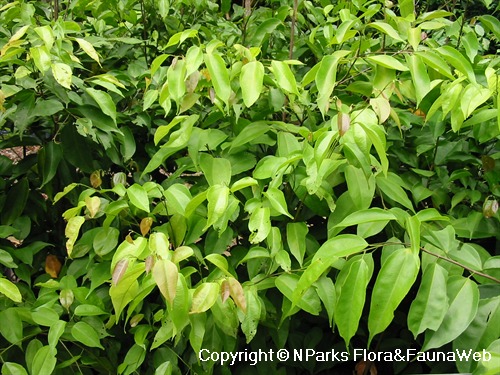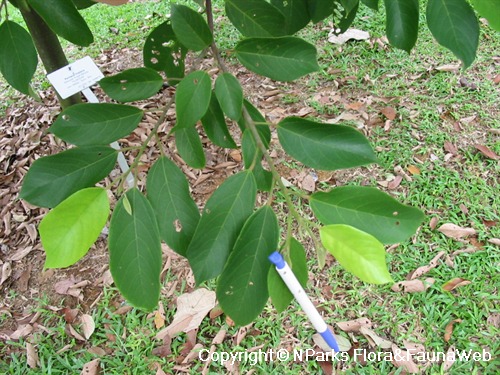Back
Pentace microlepidota Kosterm.
| Family Name: | Malvaceae |
Pentace microlepidota , also known as Melunak, is a tree, up to 60 m tall. Branches, leaves and fruits are sparsely covered with tiny hair-like scales which are shaped like a star. It produces Melunak timber, a light hardwood that is used extensively for light construction.
Name
Classifications and Characteristics
| Plant Division | Angiosperms (Flowering Seed Plants) |
|---|---|
| Plant Growth Form | Tree |
| Lifespan (in Singapore) | Perennial |
| Mode of Nutrition | Autotrophic |
| Plant Shape | Irregular |
| Maximum Height | 60 m |
Biogeography
| Native Distribution | Peninsular Malaysia |
|---|---|
| Native Habitat | Terrestrial |
| Preferred Climate Zone | Tropical |
| Local Conservation Status | Non-native |
Description and Ethnobotany
| Growth Form | It is a tree, up to 60 m tall, with buttresses up to 5 m high. The trunk can reach up to 0.8 m in diameter. The bark is smooth to scaly with lenticels in vertical rows. Branchlets are sparsely covered with tiny hair-like scales which are shaped like a star. |
|---|---|
| Foliage | Leaves are leathery, orbicular to broadly ovate (15 – 21 cm long and 10 – 22 cm wide) with toothed (crenulate) leaf margin. Each leaf has about 5 pairs of secondary veins and a prominent mid rib. The leaf tip is shortly pointed while the leaf base is cordate. The underside of the leaf is covered with a layer of small greyish hair-like scales which are shaped like a star. The petiole is 8 – 14 cm long and swollen at both ends. |
| Fruit | Fruit occur in a cluster on a fruit stalk, up to 27 cm long. The fruit stalk is covered with minute scales which are shaped like a star. Each fruit is about 3 cm long and 4 cm wide and has 5 semi-orbicular wings. The fruit is also covered with sparse minute hair-like scales. |
| Habitat | It is found in lowland rainforest. |
| Associated Fauna | Flowers are pollinated by insects. |
| Cultivation | It can be propagated by seed. |
| Etymology | Greek Pent, means five, referring to the five wings on the fruit of some species in this genus. Greek microlepidopta, means small scales, possibly with reference to the scales found on the plant. |
| Ethnobotanical Uses | Timber & Products: It produces Melunak timber, a light hardwood that is used extensively for light construction such as decorative paneling, weatherboards, furniture making, mouldings, flooring, paddles musical instruments and even gunstocks. Furniture made from Melunak timber is decorative, durable and highly sought after. |
Landscaping Features
| Landscape Uses | Parks & Gardens |
|---|
Fauna, Pollination and Dispersal
| Pollination Method(s) | Biotic (Fauna) |
|---|---|
| Seed or Spore Dispersal | Abiotic (Wind) |
Plant Care and Propagation
| Light Preference | Full Sun |
|---|---|
| Water Preference | Moderate Water |
| Plant Growth Rate | Moderate |
| Rootzone Tolerance | Well-Drained Soils |
Foliar
| Foliage Retention | Evergreen |
|---|---|
| Mature Foliage Colour(s) | Green |
| Mature Foliage Texture(s) | Leathery |
| Foliar Type | Simple / Unifoliate |
| Foliar Arrangement Along Stem | Alternate |
| Foliar Attachment to Stem | Petiolate |
| Foliar Shape(s) | |
| Foliar Venation | Pinnate / Net |
| Foliar Margin | Crenulate |
| Foliar Apex - Tip | Acuminate |
| Foliar Base | Cordate |
Non - Foliar and Storage
| Trunk Type (Non Palm) | Woody |
|---|---|
| Root Type | Underground |
Fruit, Seed and Spore
| Fruit Classification | Simple Fruit |
|---|---|
| Fruit Type | Indehiscent Dry Fruit , Samara |
| Seed Quantity Per Fruit | Few (1-5) |
References
| References | Lemmens, R.H.M.J., Soerianegara, I., and Wong, W.C. (Editors). 1995. Plant Resources of South-East Asia Volume 5 (2). Timber Trees: Minor commercial timbers. Indonesia: Prosea Foundation. 655 pages. Kostermans, A.J.G.H. (1960). Miscellaneous Botanical Notes 1. Reinwardtia 5 (3): 233 – 254. |
|---|
Image Repository
Others
| Master ID | 33924 |
|---|---|
| Species ID | 8340 |
| Flora Disclaimer | The information in this website has been compiled from reliable sources, such as reference works on medicinal plants. It is not a substitute for medical advice or treatment and NParks does not purport to provide any medical advice. Readers should always consult his/her physician before using or consuming a plant for medicinal purposes. |


